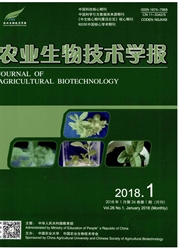

 中文摘要:
中文摘要:
为了实现大白菜遗传背景下结球甘蓝染色体、染色体片段的准确鉴定,探索结球甘蓝遗传物质的添加对大白菜的影响,本研究以不同类型大白菜(Brassica rapa,AA)和结球甘蓝(Brassica oleracea,CC)为材料,对来自结球甘蓝的797个表达序列标签简单序列重复(expressed sequence tag SSR,EST-SSRs)标记进行筛选,获得了269个结球甘蓝相对于大白菜具有多态性的标记。选取其中扩增产物清晰稳定和多态性差异明显的176个EST-SSRs,对其对应的EST序列进行BLAST分析,将EST序列与基因本体(Gene Ontology,GO)、京都基因与基因组百科全书(Kyoto Encyclopedia of Genes and Genomes,KEGG)数据库比对,获得EST序列的注释信息,其中属于细胞组件C有124条,占总数的12.29%,属于分子功能F有184条,占总数的18.24%,属于生物学途径P有688条占总数的68.19%,未知功能N有13条,占总数的1.29%。EST序列参与的生物学过程方面的功能主要集中在细胞过程、代谢过程、生物调节和刺激应答、系统形态构成、信号转导与信号传递系统、免疫系统等方面。结球甘蓝相对于大白菜多态性的EST-SSRs标记的获得,为大白菜—结球甘蓝异附加系、易位系中附加的结球甘蓝染色体及染色体片段的鉴定奠定了基础。本研究建立了EST-SSRs标记靶向基因的功能注释,为进一步推断结球甘蓝遗传物质的添加对大白菜性状的影响提供参考。
 英文摘要:
英文摘要:
Aims of this research were to well identify chromosome and chromosome fragments from cabbage under background of Chinese cabbage, and to analyze the effect of cabbage (Brassica oleracea, CC) chromosome or chromosome fragments on Chinese cabbage (Brassica rapa, AA). A total of 797 expressedsequence tag SSR (EST- SSR) markers were used to screen polymorphism between Chinese cabbage and cabbage, 269 of them were polymorphic, and 12 of them were assigned on linkage group C01, 10 of them were assigned on linkage group C02, 22 of them were assigned on linkage group C03, 10 of them were assigned linkage group on C04, 13 of them were assigned on linkage group C05, 10 of them were assigned on linkage group C06, 16 of them were assigned on linkage group C07, 14 of them were assigned on linkage group C08, 13 of them were assigned on linkage group C09, and 156 of them were NOMATCH, Scaffold or Unknown. The EST sequences corresponding 176 EST-SSRs with clear polymorphism and stable amplification between Chinese cabbage and cabbage were blasted with databases of Gene Ontology (GO) and Kyoto Encyclopedia of Genes and Genomes (KEGG). EST sequences annotations were obtained. Annotations about cell components had 124, accounting for 12.29% of the total, and mainly including organelle, membrane-enclosed lumen, cell junction, membrane, cell, macromolecular complex, extracellular region, cell part, membrance part, organelle part ect.. Annotations about molecular function had 184, representing 18.24% of the total, and mainly including catalytic activity, nucleic acid bingding transcription factor activity, protein binding transcription factor activity, structural molecule activity, transporter activity, binding, electron cartier activity etc.. Annotations about biological pathways had 688, representing 68.19% of the total, and mainly including cell metabolic processes, biological regulation and stimulus response systerm morphological structure, signal ransduction and signal transmission system, the immune system ec
 同期刊论文项目
同期刊论文项目
 同项目期刊论文
同项目期刊论文
 The Brassica rapa FLC homologue FLC2 is a key regulator of flowering time , identified through trans
The Brassica rapa FLC homologue FLC2 is a key regulator of flowering time , identified through trans The Brassica rapa FLC homologue FLC2 is a key regulator of flowering time, identified through transc
The Brassica rapa FLC homologue FLC2 is a key regulator of flowering time, identified through transc 期刊信息
期刊信息
